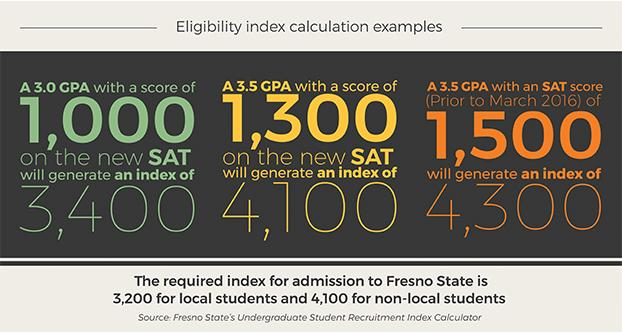With its growing population, getting into Fresno State has become more competitive in some areas. The university recently raised its eligibility index, according to Phong Yang, director of admissions and recruitment.
“We used to be an ‘open enrollment campus,’ meaning that as long as you met the minimum [California State University] requirement, which is very low, we used to take everybody,” Yang said.
The index number is calculated with the student’s GPA and SAT or ACT score, according to Yang. Admission for first-time freshmen is based on a student’s index as well as course requirements met.
A higher GPA made admission easier.
“If you had a 3.0, no questions asked. You didn’t have to have the test scores. As a freshman, you came in, you were in,” he said.
But the increased enrollment has made admission into the university more competitive. Last year, the required index (calculated using an SAT score) for local students living in the four neighboring service counties — Fresno, Madera, Kings and Tulare — was 3,100, and the index for non-local students was 3,900. This year, the required index for local students is set at 3,200 while the index for non-local students is set at 4,100.
“The bar is slightly higher, so you have higher, better, well-prepared students applying to campus to get in,” Yang said. He added that competitive admissions is a normal process.
As students await their college acceptance letters this month, many may hope for a “yes” from Fresno State. Yang said that the growing campus population and its higher eligibility indexes have made Fresno State more desirable.
“There’s definitely a value in Fresno State for sure that drives the community to want to come here,” Yang said.
Fresno State has set higher standards compared with other CSUs. California State Polytechnic University, Pomona has a similar number of students but a lower eligibility index. According to the university website, there are 25,326 students at the college. But the local area admission minimum index of 2,950 with the SAT reasoning test is lower.
CSU Chico, with 17,789 students, follows the same minimum index for local applicants ”” 2,950, according to its website. CSU Chico requires non-local students to meet an index of 3,570.
There were only about 15,000 students when Yang began working at Fresno State in 2000. Now there are roughly 25,000, he said. Yang said every year the university admits about 3,500 new freshmen with about 1,900 transfer students.
Yang said several programs at Fresno State use the stricter admissions to their advantage. While some programs require a higher index due to limited space and resources, others accept a lower index in order to bring more students into the department.
To major in computer engineering, for example, incoming freshmen need an eligibility index of 3,500 if they are local, or 4,100 if they are non-local. However, a student interested in geomatic engineering needs a local index of 3,200 or a non-local index of 3,300, allowing more students into the program, Yang said.
It’s clear that for some programs, “instead of reducing the number of students coming in, they actually are opening the gate using impaction”, Yang said.
The lower index for students living in the area allows for priority admission to serve local students first, many of whom live at home or stay in the community after graduation, Yang said. But even as the index rises, more and more students have been applying to the university.
“In order for us to maintain [the number of students admitted] based on more applicants — more qualified applicants on top of that — we have to adjust a little bit on our end so that we could still fall within the class size that we can accommodate,” Yang said.
This year, Fresno State received more than 18,000 undergraduate applications — 1,000 more than last year.
“I know that we’re not getting any less popular. I’ve been here 18 years, and every year we’ve grown,” Yang said.




